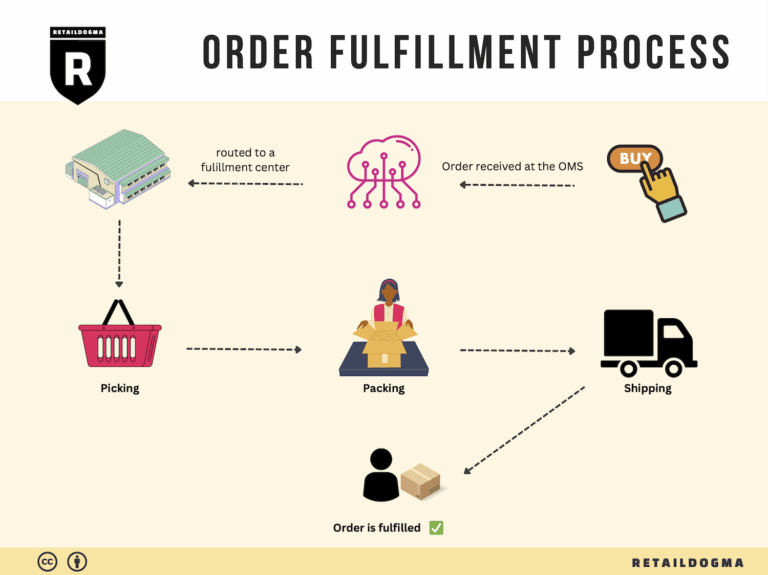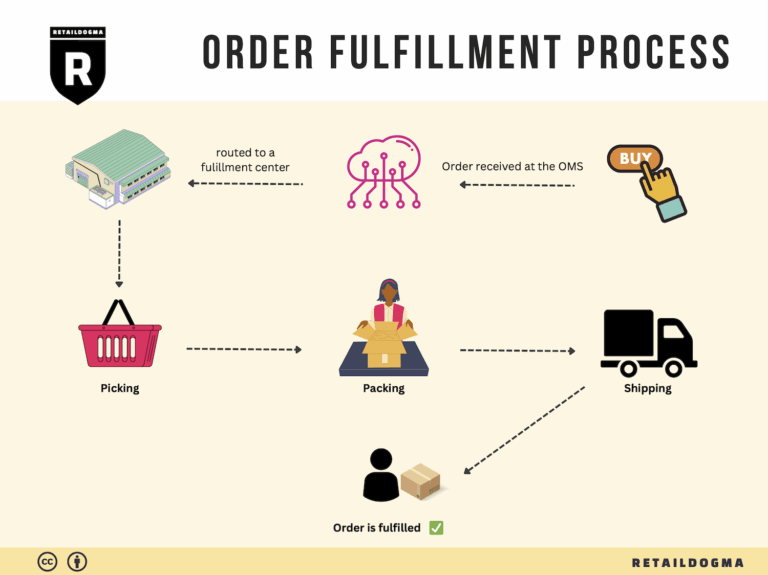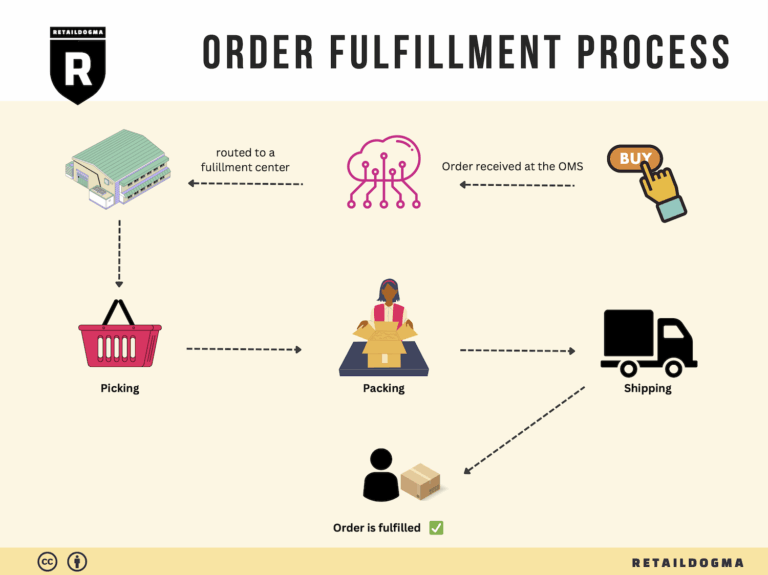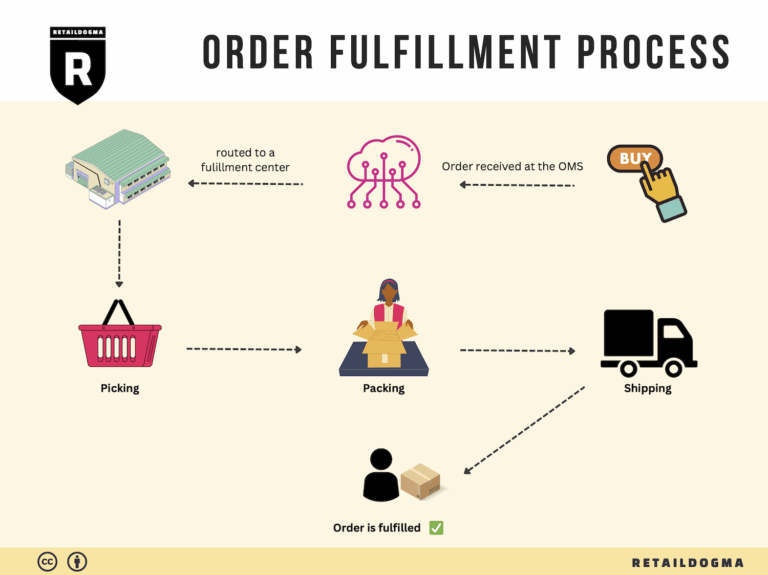Ecommerce Fulfillment Services: The Ultimate Guide (2025)
What is E-commerce Fulfillment? An Introduction for Growing Businesses
Understanding E-commerce Fulfillment
As an e-commerce business owner, you may find yourself overwhelmed by the daily grind of packing and shipping orders. The excitement of running your online store can quickly turn into frustration when managing logistics starts to consume your time and energy. This is a common pain point for growing businesses; the need to deliver products efficiently while maintaining customer satisfaction can feel like an insurmountable challenge.
At its core, e-commerce fulfillment is the process of getting a product from your inventory to your customer’s doorstep. It encompasses everything from order processing and inventory management to packing and shipping. As your business scales, the complexities of fulfillment can increase significantly, making it essential to understand your options and choose a strategy that aligns with your growth goals.
In this guide, we will explore the various fulfillment models available to e-commerce businesses, including Third-Party Logistics (3PL) and Fulfilled by Amazon (FBA). Each model offers distinct advantages and may cater to different business needs. We will delve into the core services involved in e-commerce fulfillment, such as order management, warehousing, pick and pack, and shipping. Understanding these services will help you assess what you need and what potential partners can offer.
Choosing the right fulfillment partner is crucial for your business’s success. We’ll provide insights into the key factors to consider when selecting a logistics provider, such as their technology capabilities, service reliability, and scalability options. Additionally, pricing can vary widely among fulfillment partners, so we’ll break down common pricing structures and help you understand how to evaluate costs effectively.
The goal of this guide is to empower you with the knowledge to make informed decisions about your logistics strategy. By understanding the fundamentals of e-commerce fulfillment, you can streamline your operations, enhance customer satisfaction, and ultimately drive growth for your business. Whether you’re just starting or looking to optimize your existing processes, this guide will equip you with the tools you need to navigate the evolving landscape of e-commerce fulfillment successfully.
What You’ll Learn In This Guide
- What is E-commerce Fulfillment? An Introduction for Growing Businesses
- The Order Fulfillment Process: From ‘Buy’ Button to Customer’s Door
- Comparing Fulfillment Models: In-House vs. 3PL vs. Dropshipping
- A Deep Dive into Amazon FBA: Pros, Cons, and Who It’s For
- Core Services Offered by Fulfillment Centers
- How to Choose a Fulfillment Partner: A 6-Point Checklist
- Understanding Fulfillment Pricing: A Breakdown of Common Fees
- Frequently Asked Questions (FAQs) about Fulfillment
- Conclusion: Is Outsourcing Fulfillment the Right Move for Your Business?
- Important Disclaimer
The Order Fulfillment Process: From ‘Buy’ Button to Customer’s Door
1. Receiving Inventory
The order fulfillment process begins with receiving inventory from suppliers. This step is crucial as it ensures that the right products are available for order processing. Upon arrival, each item is checked against the purchase order to confirm that the correct quantity and quality have been delivered. This process often involves the use of Stock Keeping Units (SKUs), which are unique identifiers assigned to each product.
Proper inventory management at this stage prevents stock discrepancies that can lead to order fulfillment delays. It also ensures that products are in good condition and ready for storage or immediate shipping. This step is vital for maintaining customer trust; if customers order products that are out of stock due to poor receiving practices, it can lead to dissatisfaction and lost sales.
2. Warehouse Storage
Once inventory is received, it is stored in a warehouse. Effective storage strategies are essential to optimize space and improve picking efficiency. Products are often organized by categories, sizes, or sales velocity, and this organization aids in quick retrieval during order processing.
Key terms associated with this step include “bin locations” and “FIFO” (First In, First Out). Bin locations refer to designated areas within the warehouse where specific items are stored, while FIFO ensures that older inventory is sold before newer stock to reduce spoilage and obsolescence. Proper warehouse management not only enhances operational efficiency but also reduces costs associated with excess inventory and storage.
3. Order Picking
Order picking is the process of retrieving items from the warehouse to fulfill customer orders. This step is critical as it directly impacts the speed and accuracy of order fulfillment. A well-organized picking process can significantly improve turnaround times.
In this phase, pick lists are generated, which are documents that outline the items to be collected for each order. Depending on the order volume, businesses may use various picking methods, such as single order picking (picking items for one order at a time) or batch picking (collecting items for multiple orders simultaneously). Accurate picking is essential; any errors can lead to incorrect shipments, resulting in returns and customer dissatisfaction.
4. Order Packing
After items have been picked, they move to the packing stage. This step involves carefully packaging the products to ensure they arrive at the customer’s door in pristine condition. Efficient packing not only protects the items during transit but also enhances the unboxing experience for customers.
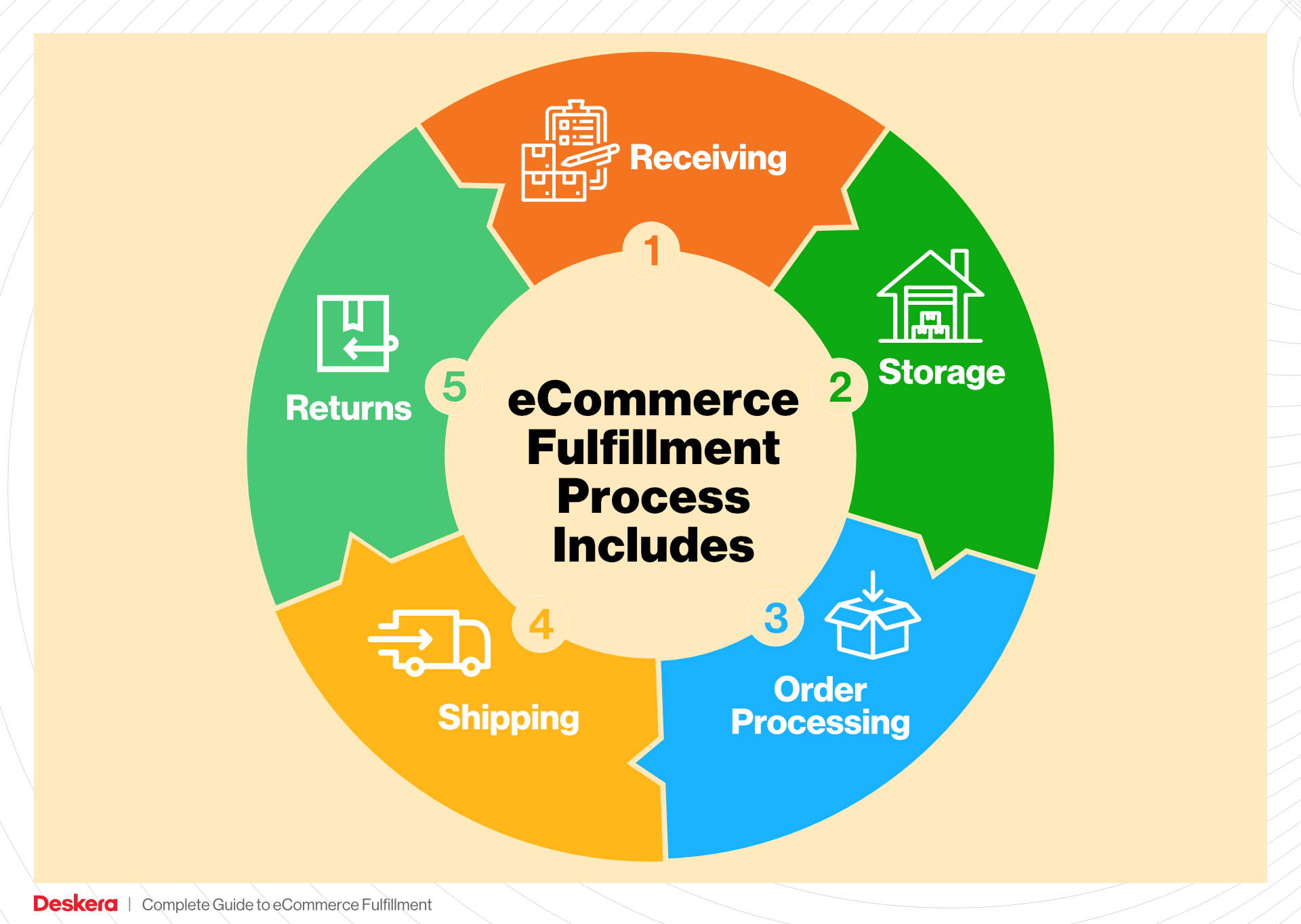
Key considerations in this step include using appropriate packaging materials and labeling packages correctly. Businesses often employ “packing slips,” which are documents that accompany the order, detailing the items inside. Effective packing minimizes the risk of damage during shipping, reduces return rates, and contributes to customer satisfaction. Additionally, it is an opportunity to reinforce branding through personalized notes or branded packaging, which can enhance the overall customer experience.
5. Shipping & Delivery
The final step in the order fulfillment process is shipping and delivery. This stage is where the product leaves the warehouse and is transported to the customer’s location. Timeliness is critical here; customers today expect fast delivery, often within a few days of placing their orders.
To achieve this, businesses utilize shipping carriers and may offer various shipping options, including express and standard delivery. Tracking numbers are provided to customers, enabling them to monitor their shipments in real-time. Efficient shipping not only fulfills customer expectations but also enhances brand reputation. Businesses that can consistently deliver products on time are more likely to see repeat purchases and increased customer loyalty.
In conclusion, mastering the order fulfillment process is essential for e-commerce businesses looking to scale. Each step—from receiving inventory to shipping and delivery—plays a critical role in ensuring customer satisfaction and operational efficiency. By focusing on best practices in each area, businesses can enhance their fulfillment capabilities, drive growth, and build lasting customer relationships.
Comparing Fulfillment Models: In-House vs. 3PL vs. Dropshipping
Fulfillment Models Overview
When it comes to fulfilling orders in the e-commerce landscape, business owners have several models to choose from, each with its unique advantages and challenges. The choice between in-house fulfillment, third-party logistics (3PL), and dropshipping can significantly impact operational efficiency, customer satisfaction, and ultimately, profitability. Below is a comparative overview of these three models.
| Model | Who Handles Inventory | Best For (Business Stage) | Key Advantage | Key Disadvantage |
|---|---|---|---|---|
| In-House Fulfillment | The e-commerce business itself | Established businesses with stable sales | Full control over inventory and processes | High overhead costs and complexity in logistics |
| Third-Party Logistics (3PL) | A separate logistics provider | Growing businesses seeking scalability | Access to expertise and reduced operational burden | Less control over inventory and fulfillment processes |
| Dropshipping | Suppliers or manufacturers | Startups or businesses testing new products | Low startup costs and minimal risk | Lower profit margins and reliance on supplier reliability |
In-House Fulfillment
In-house fulfillment involves managing the entire logistics process within the business itself. This means that the company is responsible for storing, packing, and shipping its products directly to customers. This model is best suited for established businesses with stable sales and a significant volume of orders. The key advantage of in-house fulfillment is that it provides full control over inventory management, quality assurance, and customer service. Businesses can ensure their standards are met and can quickly adapt to changes in demand or operational processes.
However, the downsides are notable. In-house fulfillment comes with high overhead costs, including warehousing, staffing, and technology investments. Additionally, managing logistics can become complex, particularly as order volumes increase. Businesses may find themselves stretched thin, leading to potential errors in order fulfillment and inventory management. This model is ideal for businesses that have the infrastructure and resources to maintain a robust logistics operation but may not be scalable for those looking to expand rapidly.
Third-Party Logistics (3PL)
Third-party logistics (3PL) refers to outsourcing fulfillment operations to a specialized logistics provider. In this model, the 3PL handles inventory storage, order processing, and shipping on behalf of the e-commerce business. This model is particularly beneficial for growing businesses that require scalability without the associated overhead costs of managing logistics in-house. By partnering with a 3PL, businesses can leverage the provider’s expertise, technology, and infrastructure, allowing them to focus on core operations such as marketing and product development.
The key advantage of 3PL is the reduction of operational burdens, as the provider takes on the complexities of logistics management. This can lead to improved efficiency and faster delivery times, which are increasingly demanded by consumers. However, the primary disadvantage is the loss of control over inventory and fulfillment processes. Businesses may face challenges in communication and coordination with their 3PL partner, potentially affecting service quality. Moreover, reliance on a third party can expose businesses to risks such as service disruptions or changes in pricing structures.
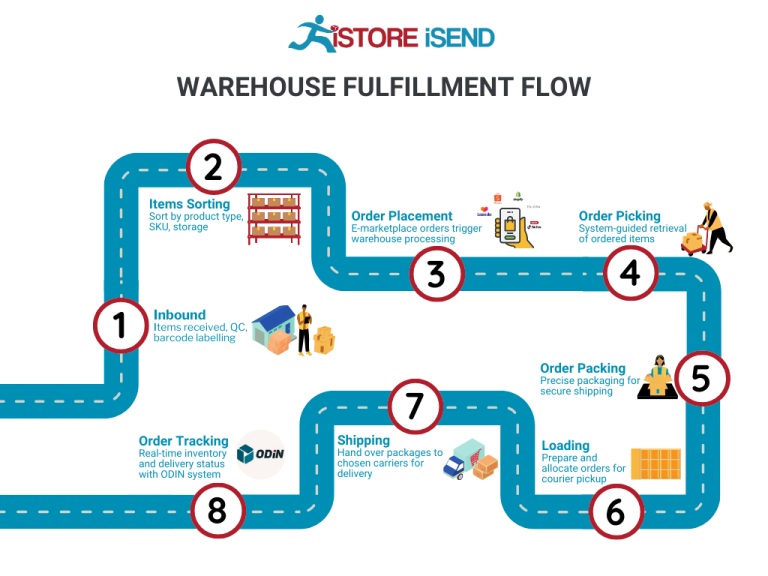
Dropshipping
Dropshipping is a fulfillment model where the e-commerce retailer does not keep products in stock. Instead, when a store sells a product, it purchases the item from a third-party supplier who then ships it directly to the customer. This model is particularly attractive for startups or businesses testing new products, as it requires minimal initial investment and low operational risk. Since there is no need for warehousing or upfront inventory purchases, businesses can focus on marketing and customer engagement.
The main advantage of dropshipping is its low barrier to entry, allowing entrepreneurs to start an online business without significant capital. It also offers flexibility in product offerings and the ability to scale quickly without the complexities of managing inventory. However, dropshipping comes with its own set of challenges. The profit margins are typically lower compared to other fulfillment models, and the retailer relies heavily on suppliers for product quality and shipping reliability. Any delays or issues with the supplier can directly impact customer satisfaction and brand reputation. Additionally, businesses may face challenges with inventory management, as stock levels can fluctuate without the retailer’s direct oversight.
Conclusion
Choosing the right fulfillment model is crucial for the success of an e-commerce business. In-house fulfillment offers control and quality assurance but can be costly and complex. 3PL provides scalability and expertise, though it comes with reduced control and potential risks. Dropshipping allows for low-risk entry into e-commerce but may lead to lower profit margins and dependency on suppliers. Each model has its place in the e-commerce ecosystem, and businesses should carefully assess their specific needs, resources, and growth ambitions before making a decision.
A Deep Dive into Amazon FBA: Pros, Cons, and Who It’s For
Understanding Fulfillment by Amazon (FBA)
Fulfillment by Amazon (FBA) is a service that allows e-commerce sellers to leverage Amazon’s vast logistics network to store, package, and ship their products. When sellers use FBA, they send their inventory to Amazon’s fulfillment centers, and Amazon takes care of the rest—from storage to shipping and even customer service. This setup allows sellers to focus on growing their business while benefiting from Amazon’s established infrastructure and customer base.
How FBA Works
-
Setting Up: Sellers create an Amazon Seller account and enroll in the FBA program. They then prepare their products according to Amazon’s guidelines and send them to designated fulfillment centers.
-
Storage: Once the products arrive at the fulfillment centers, Amazon takes responsibility for storing the items. Sellers are charged a monthly storage fee based on the amount of space their products occupy.
-
Order Processing: When a customer places an order for a product fulfilled by Amazon, the order is automatically processed. Amazon picks the item from its inventory, packages it, and ships it directly to the customer.
-
Customer Service: Amazon also handles customer inquiries and returns, providing sellers with support in managing customer relationships.
-
Payment: After the sale, sellers receive payment from Amazon, minus the applicable fees for using the FBA service.
Pros of Using FBA
1. Prime Eligibility
One of the most significant advantages of FBA is that products become eligible for Amazon Prime. This means that Prime members can enjoy free two-day shipping on eligible items, significantly increasing the likelihood of purchase. With more than 200 million Prime members worldwide, this can lead to substantial sales growth.

2. Customer Trust
Amazon has built a strong reputation for reliability and customer service. By using FBA, sellers can benefit from this trust, as customers are more likely to purchase products fulfilled by Amazon due to the perceived safety and quality of service.
3. Multi-Channel Fulfillment
FBA is not limited to sales on Amazon alone. Sellers can utilize Amazon’s fulfillment services to ship products sold on their own websites or other marketplaces. This flexibility allows for a streamlined logistics process across various sales channels, reducing complexity for sellers.
4. Simplified Logistics
FBA alleviates the burden of managing logistics, including warehousing, packing, and shipping. This allows sellers to focus on their core business activities, such as marketing and product development, while Amazon manages the logistics.
5. Increased Visibility
Products fulfilled by Amazon often receive better visibility in search results. The “Fulfilled by Amazon” badge can attract more customers, leading to higher conversion rates.
Cons of Using FBA
1. High Fees
FBA comes with various fees that can add up quickly. Sellers incur costs for storage, fulfillment, and additional services like returns. Depending on the nature of the products, these fees can significantly eat into profit margins, making it essential for sellers to calculate their pricing strategy carefully.
2. Strict Inventory Rules
Amazon has stringent inventory management rules that sellers must adhere to. This includes guidelines on how products should be packaged and labeled. Failure to comply can lead to additional fees or even the removal of inventory.
3. Commingling Risks
When using FBA, sellers’ products may be stored alongside those of other sellers. This commingling can lead to issues where customers receive products that are not from the seller they ordered from, potentially harming the seller’s brand reputation. Although Amazon offers the option to opt-out of commingling, it may complicate the fulfillment process.
4. Limited Control Over Shipping
While FBA simplifies logistics, it also means sellers have less control over the shipping process. Amazon decides how and when products are shipped, which can sometimes lead to delays that are outside the seller’s control.
5. Dependency on Amazon
Using FBA creates a dependency on Amazon’s platform and its policies. Any changes in Amazon’s terms or fees can have a direct impact on a seller’s business, making it crucial for sellers to stay informed about potential shifts in the marketplace.
Who is FBA Best For?
Fulfillment by Amazon is particularly well-suited for:
-
Small to Medium-Sized Businesses: For businesses that lack the resources to manage their logistics, FBA provides a straightforward solution to scale operations without the overhead of a full logistics team.
-
Brands with High Sales Volume: Companies that sell products with high turnover rates can benefit significantly from the speed and efficiency of FBA, allowing them to maximize sales potential.
-
Entrepreneurs Looking to Scale: Those who want to grow their e-commerce operations quickly can leverage Amazon’s infrastructure to reach a broader audience without needing to invest heavily in logistics.
-
Sellers of Low-Volume Products: FBA can be a viable option for sellers of niche products that might not have the infrastructure to handle fulfillment independently.
In conclusion, while Fulfillment by Amazon offers numerous advantages such as increased visibility, customer trust, and simplified logistics, it also comes with challenges like high fees and limited control. Careful consideration of these factors can help e-commerce business owners determine if FBA is the right fit for their scaling strategy.
Core Services Offered by Fulfillment Centers
Inventory Management & Warehousing
Inventory management and warehousing are foundational services provided by fulfillment centers, enabling businesses to maintain optimal stock levels while ensuring efficient storage and retrieval of goods. Fulfillment centers employ advanced technology, such as AI-driven inventory management systems, to track stock in real-time, forecast demand, and automate reordering processes.
Benefits to E-commerce Businesses:
1. Improved Accuracy: By utilizing sophisticated inventory management systems, fulfillment centers minimize human error, ensuring that inventory records are accurate. This leads to better stock visibility and reduced instances of stockouts or overstock situations.
-
Cost Efficiency: Efficient warehousing practices can significantly lower storage costs. Fulfillment centers optimize space usage, enabling businesses to store more products at a lower cost per unit. This is especially beneficial for e-commerce companies with fluctuating inventory needs.
-
Scalability: As e-commerce businesses grow, their inventory needs can change rapidly. Fulfillment centers offer scalable solutions that allow businesses to easily adjust their warehousing space and inventory management strategies without the need for significant capital investment in physical infrastructure.
Pick and Pack Services
Pick and pack services are critical for e-commerce businesses, as they involve the process of selecting products from the warehouse and packaging them for shipment. Fulfillment centers streamline this process using efficient workflows and technology, ensuring that orders are accurately picked and packed quickly.
Benefits to E-commerce Businesses:
1. Speed and Efficiency: Fulfillment centers are designed to handle high volumes of orders efficiently. By employing automated systems and trained staff, they can significantly reduce the time it takes to process an order, often shipping products within 24 hours. This rapid turnaround is essential in meeting customer expectations for fast delivery.
-
Customization: Many fulfillment centers offer customizable packaging options, allowing businesses to enhance their brand identity through tailored packaging solutions. This adds a personal touch to the customer experience, which can lead to increased customer loyalty and repeat purchases.
-
Error Reduction: Advanced pick and pack technologies, such as barcode scanning and automated sorting, help minimize errors in order fulfillment. Reducing the likelihood of incorrect shipments enhances customer satisfaction and reduces the costs associated with returns and exchanges.
Kitting and Assembly
Kitting and assembly services involve the process of grouping individual items together to create a single product or kit. This service is particularly useful for e-commerce businesses that sell products that need to be bundled, such as gift sets or subscription boxes.
Benefits to E-commerce Businesses:
1. Enhanced Product Offerings: Kitting allows businesses to offer unique product bundles that can attract more customers. By creating kits, companies can present a compelling value proposition, encouraging customers to purchase more items at once.
-
Streamlined Operations: By outsourcing kitting and assembly to fulfillment centers, businesses can focus on their core competencies, such as product development and marketing, rather than the logistical complexities of assembling products. This leads to greater efficiency and productivity.
-
Cost Reduction: Fulfillment centers often have the resources to assemble kits at a lower cost due to economies of scale. They can source materials and labor more efficiently than individual businesses, resulting in lower overall costs for kitting and assembly services.
Returns Management (Reverse Logistics)
Returns management, or reverse logistics, is a critical service offered by fulfillment centers to handle product returns efficiently. This process involves managing the return of products from customers back to the warehouse, assessing their condition, and determining the appropriate next steps, whether that’s restocking, refurbishing, or recycling.
Benefits to E-commerce Businesses:
1. Customer Satisfaction: A seamless returns process is essential for maintaining customer trust and loyalty. Fulfillment centers can provide an easy and efficient return process, ensuring that customers receive quick refunds or exchanges, which enhances their overall shopping experience.
-
Data Insights: Effective returns management allows businesses to gather valuable data on return reasons and trends. This information can be used to improve product quality, refine marketing strategies, and adjust inventory management practices, ultimately leading to better profitability.
-
Cost Control: Fulfillment centers can optimize reverse logistics operations, reducing the costs associated with handling returns. By efficiently processing returns and restocking items, businesses can minimize losses and recover value from returned goods.
In summary, partnering with a fulfillment center provides e-commerce businesses with a suite of essential services that enhance efficiency, improve customer satisfaction, and ultimately drive growth. By leveraging these core services, businesses can focus on scaling their operations while ensuring a high level of service to their customers.
How to Choose a Fulfillment Partner: A 6-Point Checklist
Location & Warehouse Network
Importance: The geographical location of your fulfillment partner’s warehouses directly impacts shipping times and costs. A strategically located warehouse network can significantly enhance your ability to meet customer expectations for fast delivery, especially in an era where consumers expect products delivered within three days or less.
Questions to Ask:
– What regions do your warehouses cover, and how does this align with my target customer base?
– Can you provide details on your distribution network and how it helps reduce shipping times?
– Do you have multiple facilities, and how do you determine which warehouse to fulfill an order from?
Technology & Integrations
Importance: In today’s e-commerce landscape, technology is a game-changer. A partner that leverages advanced technology, such as AI and machine learning, can optimize inventory management, streamline order processing, and improve overall efficiency. Seamless integrations with your existing systems (e.g., e-commerce platforms, inventory management tools) are crucial for maintaining operational flow.
Questions to Ask:
– What technology platforms do you use for inventory management and order processing?
– Can your systems integrate with my existing e-commerce platform and other tools?
– How do you leverage data analytics to improve fulfillment processes?
Specializations (e.g., Cold Storage, Oversized Items)
Importance: Depending on your product type, you may require specialized fulfillment services. Whether you sell perishable goods that need cold storage or oversized items that require unique handling, it’s essential to partner with a 3PL that has the necessary capabilities and experience in your specific area.
Questions to Ask:
– Do you have experience handling products similar to mine?
– What specialized services do you offer (e.g., cold storage, hazardous materials)?
– Can you provide case studies or references from clients with similar needs?
Scalability & Capacity
Importance: As your business grows, your fulfillment partner should be able to scale operations to meet increasing demand without compromising service quality. A partner with ample capacity can handle seasonal fluctuations and unexpected surges in order volume, ensuring that you can always meet customer expectations.
Questions to Ask:
– What is your current capacity, and how easily can you scale operations during peak seasons?
– Have you supported other clients through periods of rapid growth? If so, what was that experience like?
– What systems do you have in place to manage inventory and order fulfillment during high-demand periods?
Pricing and Contracts
Importance: Understanding the cost structure and contractual obligations of a fulfillment partner is vital for maintaining profitability. Transparent pricing and flexible contracts can prevent unexpected costs and ensure that you can adapt to changing business needs.
Questions to Ask:
– Can you provide a detailed breakdown of your pricing model, including any hidden fees?
– What is your contract length, and what are the terms for cancellation or changes?
– Are there discounts for long-term commitments or high-volume orders?
Customer Support & Reviews
Importance: Reliable customer support is critical for resolving issues quickly and maintaining smooth operations. Additionally, researching reviews and testimonials from other clients can provide insight into the partner’s reliability and service quality.
Questions to Ask:
– What kind of customer support do you offer (e.g., 24/7 availability, dedicated account manager)?
– How do you handle order issues or customer complaints?
– Can you provide references or case studies from current clients?
Conclusion
Choosing the right fulfillment partner is a critical decision that can influence your e-commerce business’s success. By thoroughly assessing potential partners against these six key points, you can make an informed choice that aligns with your operational needs and growth objectives. Always remember that the right partner will not only enhance your fulfillment capabilities but also contribute positively to your overall customer experience and brand reputation.
Understanding Fulfillment Pricing: A Breakdown of Common Fees
Initial Setup Fees
Initial setup fees are one-time charges incurred when you first engage a fulfillment service. These fees cover the costs associated with integrating your systems with the fulfillment center, setting up inventory management software, and creating processes tailored to your business model. This may include configuring your account, uploading product information, and establishing shipping protocols.
Typically, initial setup fees can range from a few hundred to several thousand dollars, depending on the complexity of your operations and the technology involved. For example, if you require advanced integrations with your e-commerce platform or custom reporting features, expect higher costs. It’s crucial to clarify what services are included in these fees to avoid unexpected charges later on.
Receiving Fees
Receiving fees are charged each time the fulfillment center takes in inventory. This fee compensates the facility for unloading, inspecting, and shelving your products. Receiving fees can be calculated per pallet or per item, depending on the provider’s pricing model.
For instance, if a fulfillment center charges $25 per pallet for receiving, and you send 10 pallets of goods, your receiving fee would amount to $250. Some providers may also charge additional fees for handling damaged goods or for items that require special treatment, such as refrigeration or delicate packaging. Understanding these charges upfront will help you manage your inventory costs effectively.
Storage Fees (per pallet/bin)
Storage fees are recurring charges for the space your inventory occupies in the fulfillment center. These fees can be assessed on a per-pallet or per-bin basis, typically billed monthly. The cost often depends on the size and type of your products, as larger or bulkier items may incur higher storage fees.
For example, a fulfillment center might charge $15 per pallet per month. If you have 20 pallets stored, your monthly storage fee would total $300. Additionally, some providers may implement a tiered pricing structure, where storage costs decrease as you store more inventory. Understanding how storage fees are calculated and any potential discounts can significantly impact your overall fulfillment expenses.
Pick & Pack Fees (per item/order)
Pick and pack fees are charged for the labor involved in selecting items from inventory and preparing them for shipment. This fee is usually calculated on a per-item or per-order basis. For example, if a fulfillment center charges $1.50 per item and you ship 100 items in a single order, your pick and pack fee would be $150.
Some fulfillment centers may offer tiered pricing models, where the cost per item decreases as the volume of items increases. It’s essential to analyze your average order size and frequency to accurately estimate these costs. Additionally, be aware of any extra charges for special packaging or handling requirements, as these can add up quickly.
Shipping Fees
Shipping fees are the costs associated with transporting your products to customers. These fees can vary widely based on several factors, including package weight, dimensions, shipping destination, and the chosen shipping carrier. Fulfillment centers often negotiate rates with shipping carriers, which can lead to competitive pricing.
Shipping fees can be calculated in multiple ways: flat rate, weight-based, or dimensional weight pricing. For instance, if your fulfillment center charges a flat rate of $5 for local shipping and $10 for national shipping, those would be your costs regardless of the package weight. Understanding the shipping fees structure and how it relates to your average order size will help you manage shipping costs effectively.
Tips for Getting an Accurate Quote
-
Be Detailed About Your Inventory: Provide comprehensive information about your products, including size, weight, and packaging needs. This will help fulfillment centers give you a more accurate quote.
-
Ask About Hidden Fees: Inquire about any additional costs that may not be included in the initial quote, such as returns processing or special handling fees.
-
Evaluate Volume Discounts: If you anticipate significant order volumes, ask about tiered pricing models that may lower costs as your business scales.
-
Request Custom Solutions: If your business has unique fulfillment needs, discuss custom solutions that may not be part of standard pricing models.
-
Compare Multiple Providers: Don’t settle for the first quote. Compare several fulfillment service providers to find the best pricing structure that meets your operational needs.
By understanding these common fulfillment pricing models and following these tips, you can make informed decisions that will support the growth and efficiency of your e-commerce operations.
Frequently Asked Questions (FAQs) about Fulfillment
1. What is Standvast Fulfillment?
Standvast Fulfillment is a technology-driven third-party logistics (3PL) provider that specializes in e-commerce supply chain solutions. It focuses on optimizing inventory management, order allocation, and fulfillment processes to enhance delivery speed and reliability for online retailers.
2. How does Standvast utilize technology in fulfillment?
Standvast leverages advanced technologies such as machine learning and artificial intelligence (AI) through its proprietary AI Supply Chain Platform. This platform automates demand planning, inventory management, and warehouse operations, which helps to minimize costs, improve delivery times, and streamline overall fulfillment processes.
3. What services does Standvast Fulfillment offer?
Standvast offers a comprehensive range of services, including:
– Inventory management and auto-replenishment
– Order management and tracking
– Efficient warehousing solutions
– Last-mile delivery optimization
– Returns handling
These services are designed to help e-commerce businesses scale while maintaining high levels of customer satisfaction.
4. What is a 3PL and how does it relate to Standvast?
A third-party logistics (3PL) provider like Standvast manages the logistics and supply chain operations for e-commerce businesses. This includes warehousing, fulfillment, and distribution. By partnering with a 3PL, businesses can focus on core activities such as marketing and product development while outsourcing logistics to experts.
5. How much do fulfillment services cost with Standvast?
Costs for fulfillment services can vary based on several factors, including order volume, storage needs, and specific service requirements. Standvast typically offers pricing structures that are competitive and transparent, enabling businesses to understand their costs upfront. It’s best to contact Standvast for a tailored quote based on your specific needs.
6. What is the difference between a warehouse and a fulfillment center?
A warehouse is primarily a storage facility where goods are kept until they are needed, while a fulfillment center is designed to handle the entire order processing and shipping process. Fulfillment centers focus on picking, packing, and shipping products directly to customers, which is crucial for e-commerce operations.
7. How quickly can Standvast fulfill orders?
Standvast aims to meet the growing consumer demand for speed by delivering orders within a two to three-day window. Utilizing their technology-driven processes and strategically located fulfillment centers, they are equipped to expedite order processing and shipment.
8. What are the benefits of partnering with Standvast Fulfillment?
Partnering with Standvast provides numerous benefits, including:
– Enhanced delivery speed, which can lead to increased conversion rates
– Advanced technology for inventory and order management
– Cost-effective solutions that lower total logistics expenses
– Improved customer satisfaction and loyalty through reliable service
9. How does Standvast handle inventory management?
Standvast employs an auto-replenishment solution that optimizes inventory levels, ensuring that businesses maintain optimal stock without over-investing. Their AI-driven platform continuously analyzes sales data to adjust inventory levels dynamically, reducing the risk of stockouts and excess inventory.
10. Can Standvast accommodate seasonal fluctuations in order volume?
Yes, Standvast is designed to handle fluctuations in order volume, whether seasonal spikes or unexpected surges. Their flexible warehousing and fulfillment solutions allow businesses to scale operations up or down as needed, ensuring that they can meet customer demand without compromising service quality.
Conclusion: Is Outsourcing Fulfillment the Right Move for Your Business?
The Strategic Advantage of Outsourcing Fulfillment
Outsourcing fulfillment can be a game-changer for e-commerce businesses looking to scale. By partnering with a specialized fulfillment service, you can save valuable time and resources that would otherwise be spent on managing logistics. This allows you to focus on core business activities such as marketing, product development, and customer engagement, ultimately driving growth.
One of the most significant advantages of working with a fulfillment partner is scalability. As your sales volume increases, a proficient fulfillment service can adjust to your needs without the burden of managing additional warehouse space or staff. This adaptability ensures you can meet customer demands without compromising service quality, crucial in today’s competitive landscape where speed and reliability are paramount.
Moreover, fulfillment services bring expertise that can enhance your operational efficiency. With advanced technology and seasoned professionals, these partners streamline inventory management, order processing, and shipping. For instance, companies like Standvast leverage machine learning and AI to optimize their supply chain processes, resulting in faster deliveries and reduced costs. Such expertise not only improves your service levels but also boosts customer satisfaction and loyalty.
However, the success of outsourcing fulfillment largely hinges on choosing the right partner. Conduct thorough research to find a fulfillment service that aligns with your business goals and can scale alongside you. Evaluate their technology, customer service, and operational capabilities to ensure they can meet your specific needs.
Take Action Today
To determine if outsourcing fulfillment is the right move for your business, conduct an audit of your current shipping processes. Analyze your delivery times, costs, and customer feedback. This insight will help you make an informed decision on whether a fulfillment partner could enhance your operational efficiency and support your growth objectives. Embrace the opportunity to optimize your logistics and position your business for success in the ever-evolving e-commerce landscape.
Important Disclaimer
⚠️ Important Disclaimer
The information in this guide is for educational purposes. Fulfillment services, pricing, and platform features change frequently. Always conduct your own due diligence and consult with providers directly before making business decisions.

